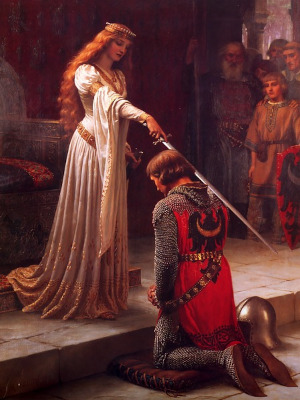The Middle Ages describe the time period between around 500 AD and 1500 AD. For most people, it is not really imaginable to live how people used to live back in these former times. Nowadays, life has a lot of perks, like access to health care and advanced and new technological achievements. Also, in transportation aspects, mankind achieved the (then) unthinkable: to fly in the air like a bird. Also, there are trains that are way faster than a cheetah, who is the fastest animal in the world (120 km/h). Back then, life was different, with different values and traditions.
The two most important aspects of daily life in the Middle Ages were agricultural work and religion. It was common for the majority of people to live in rather small villages and work as farmers who spent their time outside while cultivating the fields. The role that the church played in the lives of the people was of great significance. It guided them in their spiritual and moral ways and supported them in their roles in society. Also, the population of the Middle Ages had a much harder time in their everyday lives than we have nowadays. Since they did not have access to very good medical care, it was just a matter of time until diseases spread, and unfortunately, a lot of people did lose the fight against illnesses at an early age.
Feudalism
Mediaeval life was defined by feudalism. Society was made up of the king, nobles, knights, clergy, and peasants. Loyal nobles received estates, or “fiefs,” from the monarch. These aristocrats gave knights, who pledged to defend them, portions of their estates. The bulk of the people who worked to develop these fields from sunrise to nightfall were peasants. Even though they were the backbone of civilisation, they shared the same land and had few privileges.
Clothing in mediaeval times
The way a person in the mediaeval ages dressed was an indicator of their social status. Women wore long dresses, and men who worked as peasants wore simple tunics made from woollen or linen material with an attached breech. Contrary to the peasant’s clothing, the high society wore high-quality clothes that were often made from silk materials that were embroidered. Leather shoes were common, and if someone wore a hat, then he or she was most likely to be rich.
Diet in the mediaeval ages
The lower social classes used to eat a lot of rye or barley bread, seasonal vegetables, and cheese. However, wealthy people also ate a variety of fruits, spices, fish, meat, and wine.
Mediaeval professions
A big part of the people in the middle ages worked in the craft field, so there were many positions as weavers, bakers, craftsmen, and carpenters, and they gave on their skills to their children and later generations. Also, it was common for craftsmen to form a guild. In these guilds, they learned about traits like protection, standards, and training. They also shared all their possessions with their fellow guild members.
Life as a knight
Among the nobility, the knights were an important part of the social structures. Traits like bravery, loyalty, and honour contributed to the profile of a good knight who served a lord. The career of becoming a knight begins at an early age, with the position of a page, then a squire, and eventually a knight.
Religion and influence of the church in the Middle Ages
Church members had a strong influence on mediaeval society. Living in the middle ages also meant for the most people to take an active part in the church community. Also, the religious holidays were of great significance and determined the calendar of the people.
Education in mediaeval times
Education and study lessons were most of the time only reserved for wealthy and aristocratic people. The teaching subjects included lessons about law, theology, and medicine. In a prosperous society, it was also common to receive home tutoring lessons. The lower social classes were mostly illiterate.
Europe in the Middle Ages
As mentioned earlier, mediaeval life was all about work, religion, and social order of precedence. The lives of the peasants revolved around the labour that they did for the nobles that owned the lands. For the nobility, however, the main focus was on military duties, educational studies, or prayers and their relationship with religion.

Sources:
https://www.historyforkids.net/medieval-daily-life.html
https://en.wikipedia.org/wiki/Middle_Ages
https://kinder.wdr.de/tv/wissen-macht-ah/bibliothek/kuriosah/bibliothek-die-schnellsten-tiere-der-welt-100.html
